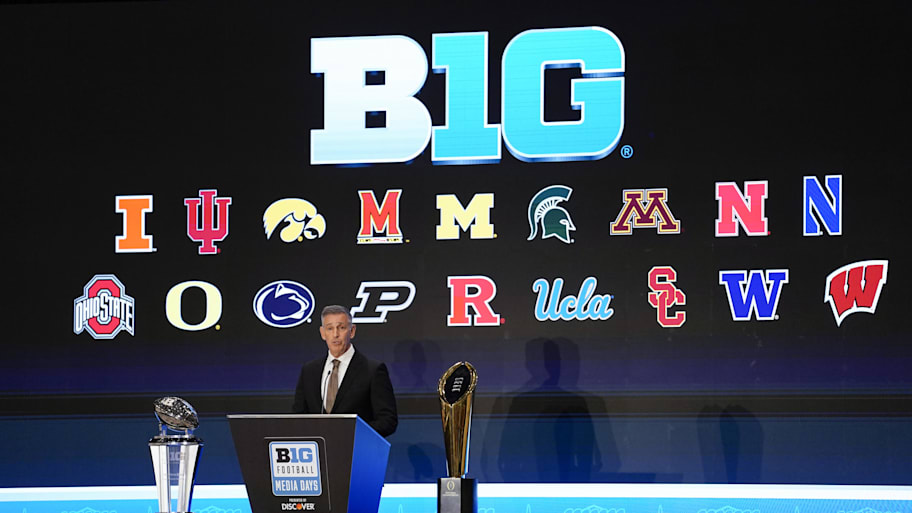LAS VEGAS — Big Ten commissioner Tony Petitti’s entrenched position regarding a controversial future College Football Playoff format has sparked a question: Why is he so committed to a largely unpopular position?
One answer, according to four sources familiar with CFP discussions, is that Petitti has made assurances of a play-in payday for Big Ten broadcast partners and campus administrators. That major alteration to the way college football is played would require a format that delivers four automatic bids from three games: the top two teams facing off for the Big Ten championship, with both guaranteed a CFP spot; a matchup of the third-place and sixth-place programs with the winner advancing to the playoff; and a game between the fourth-place and fifth-place teams for a CFP bid.
Those games would provide potentially lucrative postseason inventory to three broadcast partners that are not part of the actual playoff. ESPN has the primary rights to air the playoff but has sub-licensed multiple CFP games per year to TNT through the 2028 season.
If Petitti gets his play-in format, sources say a likely broadcast plan would call for Fox to air the Big Ten championship game, as it currently does, with one of the play-in games on NBC and the other on CBS, the Big Ten’s other primary broadcast partners.
With the Southeastern Conference pivoting away from support for a so-called “4-4-2-2-1” format—four bids each for the Big Ten and SEC, two apiece for the Big 12 and ACC and one for a Group of 6 conference champion—the Big Ten now appears to be on an island. Neither Big 12 commissioner Brett Yormark nor ACC boss Jim Phillips are aligned with Petitti, either.
“He’s gotten way out over his skis,” a source said of Petitti. “He’s lost the room.”
When asked whether the Big Ten has made an assurance of a play-in round to broadcast partners or campus leaders, league spokeswoman Diane Dietz said, “No, that’s not true.”
Petitti lost the support of SEC commissioner Greg Sankey for the four automatic bid premise in the spring, when Sankey’s football coaches told him they preferred a 16-team format with one automatic bid for five conferences and 11 at-large selections. The Big Ten has indicated it would only support such a format if the SEC increases its number of conference games from eight to nine. The Big Ten currently plays nine league contests.
“Each league will decide what they think the best conference schedule is for them,” Petitti said in his opening remarks at Big Ten media days Tuesday. “I think in a system where you have allocated spots, talking with our athletic directors and coaches, I don’t think they care how many conference games a league is playing. But when you have a system that’s increasing the at-large bids and increasing the work of a selection committee, that’s when you need to understand how we’re competing in the regular season.
“At the end of the day, it’s really simple math: With 18 schools and nine conference games, we’re losing nine more games to start. That’s really relevant.”

The SEC has long wrestled with the idea of whether or not to add a ninth game. The league has been split almost evenly in the past, with schools that generally finish in the bottom half of the standings wanting to stay at eight. At present, there does not appear to be enough support for moving to nine games.
With Petitti unlikely to unilaterally cede ground on the playoff without the SEC adding a ninth game, an impasse on future format plans is a real possibility. If gridlock continues through Dec. 1, a date Sankey said was the deadline for 2026, the current 12-team model could remain in place.
“The entire country knows 4-4-2-2-1 is a rigged system,” one source said. “[Petitti] overpromised his league and can’t walk it back.”
Big Ten coaches continued to voice public support for Petitti, with several also championing his automatic bid proposal. Washington coach Jedd Fisch called the Big Ten the “best conference in football” and cast a wary eye at a five-plus-11 playoff format.
“For the last two seasons, our conference showed its strength and dominance with back-to-back national champions,” Fisch said. “I don’t think you prepare any better for the NFL than playing in our conference. Every week you have to travel, just like the NFL. It is not a regional league.
“It’s a national league. I would tell you, as we go, that’s why it’s so imperative we need four automatic bids, a nine-game schedule in the Big Ten Conference. We can’t leave it up to chance with a 5–11 combo.”
Indiana coach Curt Cignetti took it a step further Tuesday. When asked about dropping a series with Virginia to add a non-power-conference opponent—after dropping a game at Louisville last year—Cignetti took a direct shot at the SEC’s eight-game conference schedules.
“We figured we would just adopt SEC scheduling philosophy, you know,” Cignetti said. “Some people don’t like it. I’m more focused in on those nine conference games. Not only do we want to play nine conference games … we want to have play-in games to decide who plays in those playoffs.
“Championship weekend, let’s play three versus six and four versus five. You want to decide that on the field and make sure everybody’s strength of schedule is what it needs to be? Let’s make everybody play nine conference games.”
Petitti made the point Tuesday that the SEC and Big Ten have been in active collaboration on numerous topics, the playoff included. The leagues’ coaches and administrators have met twice within the last year, and there is an overall atmosphere of cooperation between the two, even if they do not currently agree on a playoff format.
“Every time we’ve come together with the two leagues, good things have happened,” Petitti said. “Not just for the two conferences.”
Another source reinforced the positive working relationship between Petitti and Sankey. “This isn’t like the days with [former Big Ten commissioner] Kevin Warren,” the source says. “There is no cold war.”
More College Football on Sports Illustrated
This article was originally published on www.si.com as Sources: Big Ten’s Four-Bid CFP Push Tied to TV Revenue Proposal.
